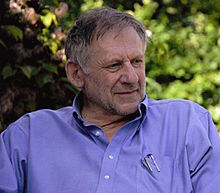
Christopher ALEXANDER
Christopher Alexander è un architetto e teorico del design, meglio conosciuto per il suo libro “A Pattern Language“, che ha influenzato generazioni di architetti e designer. Nato a Vienna, in Austria, nel 1936, Alexander ha studiato all’Università di Oxford e all’Università di Harvard. Ha insegnato all’Università della California a Berkeley e all’Università dell’Illinois a Urbana-Champaign. La sua carriera iniziale è stata dedicata a progetti di design di grandi dimensioni, tra cui il Centre Pompidou di Parigi e il piano urbanistico di Vancouver Harvard. Negli anni ’70, ha iniziato a sviluppare la sua teoria dei pattern, descritta per la prima volta in “A Pattern Language”. Questo libro è stato tradotto in più di 25 lingue (ma non in italiano) e ha venduto oltre 2 milioni di copie. Rimane uno dei libri più influenti su design e architettura. Negli ultimi anni, Alexander si è concentrato sul ruolo dei pattern nella progettazione di software e sistemi. È il fondatore del Center for Environmental Structure, che si dedica alla ricerca e allo sviluppo di nuovi metodi di progettazione.
Insegnò presso l’Università della California e curò la progettazione di edifici complessi in California, Giappone e Messico. Collaborò con il matematico Nikos Salingaros per la definizione di un nuovo approccio teorico all’architettura. Il suo libro A pattern language descrive un sistema architettonico in modo scientifico, attraverso 253 pattern che risolvono problemi comuni delle città.
Con il suo libro Note sulla sintesi della forma ha influenzato il linguaggio di programmazione verso la programmazione ad oggetti.
Ha vinto nel 2009 il Vincent Scully Prize.
Christopher Wolfgang John Alexander (4 October 1936 – 17 March 2022)[1][2][3] was an Austrian-born British-American architect and design theorist. He was an emeritus professor at the University of California, Berkeley. His theories about the nature of human-centered design have affected fields beyond architecture, including urban design, software, and sociology.[4] Alexander designed and personally built over 100 buildings, both as an architect and a general contractor.[5][6]
In software, Alexander is regarded as the father of the pattern language movement. The first wiki—the technology behind Wikipedia—led directly from Alexander’s work, according to its creator, Ward Cunningham.[7][8][9] Alexander’s work has also influenced the development of agile software development.[9]
In architecture, Alexander’s work is used by a number of different contemporary architectural communities of practice, including the New Urbanist movement, to help people to reclaim control over their own built environment.[10] However, Alexander was controversial among some mainstream architects and critics, in part because his work was often harshly critical of much of contemporary architectural theory and practice.[11]
Alexander is known for many books on the design and building process, including Notes on the Synthesis of Form, A City is Not a Tree (first published as a paper and re-published in book form in 2015), The Timeless Way of Building, A New Theory of Urban Design, and The Oregon Experiment. More recently he published the four-volume The Nature of Order: An Essay on the Art of Building and the Nature of the Universe, about his newer theories of “morphogenetic” processes, and The Battle for the Life and Beauty of the Earth, about the implementation of his theories in a large building project in Japan. All his works are developed or accumulated from his previous works, so his works should be read as a whole rather than fragmented pieces. His life’s work or the best of his works is The Nature of Order on which he spent about 30 years, and the very first version of The Nature of Order was done in 1981, one year before a famous debate with Peter Eisenman at Harvard.
Alexander is perhaps best known for his 1977 book A Pattern Language, a perennial seller some four decades after publication.[12] Reasoning that users are more sensitive to their needs than any architect could be,[13][14][15] he produced and validated (in collaboration with his students Sara Ishikawa, Murray Silverstein, Max Jacobson, Ingrid King, and Shlomo Angel) a “pattern language” to empower anyone to design and build at any scale.